To cool to 60 degrees 2 liters. Refrigeration unit for the cellar: self-production, features of the water plant and other cooling methods
Option 1
I
What amount of heat is required to heat a steel part weighing 200 g from 35 to 1235 °C?
How much energy was released when a piece of copper weighing 0.6 kg was cooled from 272 to 22 °C?
How much heat will be released when burning 3.5 kg of peat?
II
To heat 400 g of lead from 25 to 45 ° C, an amount of heat of 1120 J is required. Determine the specific heat capacity of lead.
How much heat is required to boil 2 kg of water in a 700 g aluminum kettle? The initial water temperature is 20 °C.
By how many degrees will 4 kg of water heat up when burning 30 g of coal, if we assume that all the energy released during the combustion of coal will be used to heat water?
Sometimes people invest more money thinking that buying a compressor with a larger tank will work better when the purchase is not needed. What are the electricity requirements? Determine the electrical service before installing the air compressor. Always have a qualified electrician check the electrical needs. If you are not running an electric compressor, there is an option for a combustion engine compressor.
You should be able to select an air compressor with this information. Basically, you need to ultimately decide what you are going to use the device for and choose the right model. But remember that if you need advice, you can contact us.
III
Mercury, the mass of which is equal to the mass of water, is poured into water at a temperature of 20 °C. Determine the initial temperature of mercury if the steady state temperature is 21°C.
How many grams of charcoal must be burned in a samovar with a capacity of 5 liters in order to heat water in it from 20 to 100 ° C? Keep in mind that only 25% of the energy released is used for heating.
To cool 2 liters of water taken at a temperature of 80 °C to 60 °C, cold water is added to it, the temperature of which is 10 °C. How many liters of cold water do you need to add?
In any tropical freshwater aquarium or sea water an aquarium heating system is required. This allows you to adjust the aquarium water temperature for which it is suitable for your population. The aquarium heater has a heating resistor controlled by a thermostat. This is triggered according to the selected temperature. There are 2 types of thermostats: bimetal and electronic thermostats.
Choose an aquarium heater
Approximately 1 watt per liter is required: a 250 watt heater works well for a 250 liter aquarium. There are always differences between brands. The aquarium water temperature should be checked daily to make sure the heating system is working properly. Similarly, you should never turn off the heat, even when it's hot: it's the best way to forget about reconnecting it when the temperature drops and run to disaster.
KR-1. Calculation of the amount of heat
Option 2
I
How much heat is required to heat a brick weighing 4 kg from 15 to 30 °C?
How much heat is given to the environment by boiling water weighing 3 kg when cooled to 50 ° C?
How much energy is released during the complete combustion of 4 tons of coal?
II
What mass of water can be heated from 0 to 60 °C, giving it an amount of heat of 500 kJ?
Determine how much heat is required to heat a mixture of 300 g of water and 50 g of alcohol from 20 to 70 °C.
How many grams of alcohol will be required to heat 3 kg of water at a temperature of 20 °C to boiling point? Ignore heat loss.
The temperature in apartments often rises too much in summer so that the aquarium does not suffer any consequences. In some cases, it is necessary to act so that the fish does not cook! In the event of a rise in temperature, several things can be created.
Reduce the lighting duration a bit to avoid the heat caused by the neon. It can also sunbathe the tray at night when it's cooler and turn off the day. In this case, it is necessary to keep the room well. In the dark in the day, if all the water temperature increases, the best solution is to ventilate the surface with a constant fan or a table fan. When it evaporates, the water will lose a few degrees. On the other hand, you need to add water regularly. This method seems to be quite effective when the room temperature remains reasonable.
III
In water weighing 5 kg, taken at a temperature of 7 CC, a piece of iron heated to 540 ° C was immersed. Determine the mass of iron if the temperature of the mixture is 40°C.
The heater tank contains 800 g of kerosene. How many liters of water can be heated with this amount of kerosene from 10 to 100 °C if 40% of the released energy is spent on heating?
A metal cylinder weighing 200 g was heated in boiling water to 100°C and then lowered into water weighing 400 g having a temperature of 22°C. After some time, the temperature of the water and the cylinder became equal to 25 °C. What is specific heat what metal is the cylinder made of?
Don't forget to oxygenate the water enough: even if your tank is well planted and you never use a bubbler, this becomes necessary in case of hot weather. If your filter is equipped with a Venturi system, it is even better: it is a system that sucks air from the surface and transfers it to the discharge, then the water is very well oxidized.
Avoid putting ice in the tank at all costs, it is unconvincing and harmful to the fish. If, despite everything, the water temperature is too high, there is no longer any solution if it does not cool the room or cools the aquarium with a refrigeration unit.
KR-1. Calculation of the amount of heat
Option 3
I
When processing an aluminum part on a machine, its temperature increased from 20 to 420 °C. By how much did the internal energy of the part change if its mass is 500 g?
What amount of heat will be released when a lead part with a mass of 400 g is cooled by 80 ° C?
How much heat will be released during the complete combustion of 20 g of hydrogen?
My drawer is equipped with an external filter, which is important because the refrigeration unit does not have a pump. If you have a sump fitted with an internal filter, you must add a pump to create a flow of water within the cold group. In my case, the water is sucked in by my filter pump. The water is filtered and removed to a cold plant. Depending on its temperature, it cools down and, thanks to the strength of my filter pump, is sent back to the aquarium.
It is very easy to use. We set the desired temperature once and for all. If the cold block is disconnected, the set temperature remains. Then the device starts up automatically. Thus, it works autonomously 4-5 times a day for about 20 minutes.
II
By how many degrees will 40 g of ice cool if it gives off an amount of heat of 500 J?
An aluminum pan weighing 250 g holds 2 kg of milk. How much heat is required to heat the milk in this saucepan from 15 to 100 °C?
Calculate the mass of kerosene that will need to be burned in order to heat 10 kg of water from 10 to 80 ° C, assuming that all the energy released during the combustion of kerosene will go to heat the water.
Are the results convincing? It's important to always choose a superheated cold set over in fact, manufacturers tend to overestimate the power of equipment. If you take a cold group planned for 300 liters and your tank is 250, it won't be enough in hot weather. Comparable systems already existed on the shores of North American lakes, but the water is much colder and there is no need to go as deep as the ocean. The first person to tell me about it technically is Marlon Brando, with whom we worked on the development of his atoll, says Richard Bailey.
III
Determine what part of the energy (in%) is spent on heating water with an alcohol lamp if 5 g of alcohol were burned to heat 100 g of water from 20 to 90 ° C.
For the bath, it is necessary to prepare water with a temperature of 36 ° C. Water flows from the hot tap of the mixer at a temperature of 80 ° C, and from the cold tap at 8 ° C. How much to take hot water to prepare a bath if it requires 196 kg of cold water?
How will the temperature of water with a mass of 880 g change if it is given the same amount of heat that goes into heating an aluminum cylinder with a mass of 2 kg by 200 °C?
In an effort to develop sophisticated and expensive devices to try and generate electricity by taking advantage of the temperature difference between the surface and the ocean floor, scientists realized that a system could be very simple and very effective for air conditioning. Instead of trying to generate energy to run conventional air conditioners, it's easier to get cold from the depths and cold water to rise to the surface. heat, cools the secondary circuit of fresh water, which then circulates in all buildings.
The air is cooled by small fans that blow directly onto the cold water pipes. “Taking into account the electricity for the pump and fans, the system saves 90% of the energy of a conventional air conditioner, which is the equivalent of 2.5 million liters of fuel per year,” explains Christophe Modet, deputy director of the InterContinental Hotel in Bora Bora. In addition, the system avoids the use of refrigerant gases, among others. This success has been emulated and numerous projects of the same type are being explored around the world.
KR-1. Calculation of the amount of heat
Option 4
I
How much heat is released when 3 tons of cast iron cools down to 100 °C?
What amount of heat is needed to heat a 100 g brass weight from 10 to 40 °C?
Determine the amount of heat released when burning 50 kg of firewood.
II
How many grams of steel can be heated by 20 ° C, giving it an amount of heat of 1500 J?
Cold well water weighing 100 kg was poured into an iron shower tank with a mass of 60 kg. Under the action of solar radiation, the water temperature increased from 4 to 30 °C. How much heat was received by the tank and water?
What mass of water can be heated from 30 ° C to boiling, using 2 kg of firewood? Ignore heat loss
The main limitation is the very steep ocean slope, as in the islands of Polynesia, which allows access very quickly to very cold waters, which excludes areas such as the Seychelles or the Maldives. We learned about power and that everything has to match the power supply.
From the head of government, you know that everything should be different not only physically, but also fireproof. Essentially, you should never have concatenations in the same space, or you can't cross cables anywhere. There also needs to be physical separation not only for power, but also for piping and any supporting cables. Everything should be separate in different spaces and at the same time nothing should cross.
III
How many grams of kerosene must be burned to bring 4 liters of water to a boil if the initial temperature of the water is 20 °C and 25% of the energy is spent unproductively?
200 g of water, the temperature of which is 100°C, is poured into a glass beaker weighing 120 g and having a temperature of 15°C. At what temperature will thermal equilibrium be established? energy exchange with environment neglect.
Water at a temperature of 20°C and water at a temperature of 100°C were mixed in a vessel. After some time, the temperature of 40 °C was established in the vessel. Calculate the mass ratio of cold and hot water
Of course, the physical separation does not only apply to indoor units and wiring, but also to outdoor units that cannot be "just side by side". Here it is also necessary to ensure that everything is sufficiently separated, both for physical safety and to reduce the risk of any accident, as well as for fire. Wiring and piping must be separate.
Everything must be fully serviced, so you can always ensure 100% cooling of the entire data center. Cooling must be provided to ensure safe cooling in all situations. Therefore, even in case of extreme outside temperatures. This rating is based on critical values for a given location and is evaluated on a case-by-case basis.
Attached files
How to cool the cellar in summer? In the article, we will figure out what a thermoregulation system is for food storage. In addition, we will look at other ways to keep underground storage cool enough to store fruits and vegetables.
So all cooling must be at least 2N or 2. This means you have at least 2 times more air conditioner than you need to charge 100% of the entire data center in any weather. Ideally, each cooling branch should have one additional air conditioner to replace in the event of a failure of any of the units. Cooling systems dependent on cooling water must have a guaranteed water supply for at least 12 hours of operation, and separate water supply for each branch.
Cooling typically works such that if the data center power supply fails, the motor generator continues to run and there is currently a short break. Here, however, we may run into the problem that this unplanned outage is the source of frequent failures and at the same time believes that even a minute of cooling failure can mean several degrees of temperature increase for the data center.
Requirements
First, let's find out which mode is optimal for the cellar.
For storage of most garden crops, the optimal temperature range is from +1 to +12 degrees. When this value is exceeded, activity increases sharply. aerobic bacteria, which quickly and efficiently process the richest crop into a monotonous rotting mass. At temperatures below zero, water crystallization begins, as a result of which the cell membranes of the fruits are damaged; as a result, they lose their natural taste.
Do you know how sensitive the cooling center is?
Today you can buy servers where the manufacturers guarantee that the servers can work up to 30 or up to 33 or even up to 40 degrees of temperature inside the data center. At temperatures above 27 degrees, we notice a significantly higher component failure rate, especially spinning discs. During normal operation, when the servers are cooled to about 17 degrees, we change 1-3 disks per month. At temperatures above 27 degrees, we also change the same number per day.
In the current data center, we need 2 air conditioners to run the server. We will have a total of 4 participants, one pair is on one branch and the other pair is on the other. They will not be linked, they will not be controlled, and they will not be transmitted together.
What's with the humidity? Typically, the range of 80-95 percent is considered optimal. Too dry air will cause fruits and vegetables to quickly evaporate their own moisture; as a result, your stock will not rot, but will dry up.
To clarify: this applies only to those products that are stored in an open form, without sealed containers.
When it comes to home canning, a simple rule applies: the lower the humidity in the cellar, the better.In today's data center, we have a very economical form of cooling. This is direct free cooling, a simplified, huge fan that sucks cold air from outside, which passes through special filters and then mixes in a "mixing" chamber at a constant temperature. This air blows into the two-story floor and is directed to the so-called cold aisles. The servers run through and warm up to 32 degrees and then suck out the second fan. Before it goes out, it is used for "constant temperature mixing" in the mixing chamber.
How realistic is it to maintain such a regime in the summer heat?
The temperature of the soil below the freezing level is quite stable and stays in the range of 6-12 degrees all year round, which fits well into the voiced requirements.
However, at high outdoor temperatures, both the soil surface and the rooms located above the cellar warm up. There is no escape from the old woman-entropy: thermal energy tends to be evenly distributed throughout the available space, and the temperature in the cellar begins to creep up over time.
It is also used to heat our entire building, which we heat with this air alone without a single fan or one watt of any other energy. The remaining warm air that is not used in the mixing chamber is blown out to heat the building.
We've taken things a step further in the new data center. We want the servers to be cooled in an oil bath. Imagine servers floating in oil. All components are immersed in an oil bath to keep them cool. Each bath will be connected to two independent cooling circuits, with each cooling circuit connected to two different sources of cooling water. The building will have two non-conductive oil cooling circuits and the heat from these circuits will be transferred to a heat exchanger.
Solutions
So, how to cool the cellar?
The obvious solution is a household appliance to maintain a comfortable temperature, an air conditioner. It is a heat pump, a machine for pumping thermal energy from one point to another. Since electricity is spent only on the operation of the compressor, the useful thermal power of the air conditioner (the number of kilowatts of heat that the device is able to transport per unit time) significantly exceeds its electrical power.
However, here's the sadness: the absolute minimum that can be set to maintain household air conditioners is 16 degrees.
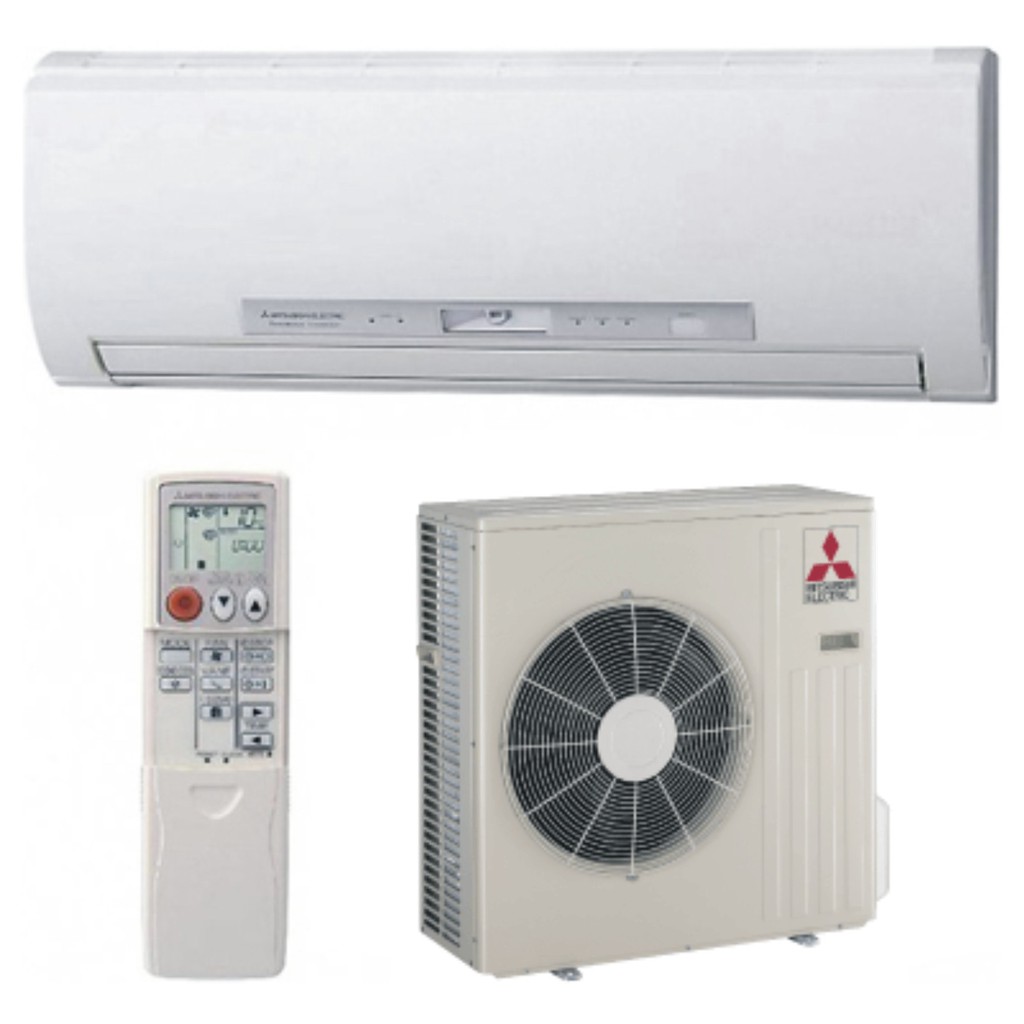
A domestic air conditioner is the most obvious solution. And, alas, absolutely inappropriate.
We need a significantly lower temperature. How can it be provided?
Refrigeration unit
Industrially produced devices of this type are still the same heat pump.
How do they work?
- The compressor compresses the freon gas. When compressed, he, remembering the physical laws, obediently heats up; excess heat is given off to the radiator and blown off by a large fan.
- Having passed the radiator of the condensing part of the device, liquid freon is supplied through the expansion valve into a tube of a significantly larger diameter. The pressure drops, and the liquid immediately turns into a gaseous state. At the same time, in full accordance with the notorious laws of physics, it cools down; blowing the evaporator radiator dramatically increases the amount of heat that freon takes away from the environment.
Of course, a specialized refrigeration unit for a cellar has some differences from a household air conditioner.
- The temperature range is shifted closer to the bottom of the thermometer. Usually the temperature is maintained from -5 to +12 degrees.
- Much less attention is paid to the external design of the unit, since it is focused on industrial conditions. Many refrigeration units are devoid of casings; the compressor and forced draft condenser are mounted on a steel frame, which is designed to be installed on a separate foundation. The evaporator is a separate device connected by copper lines.
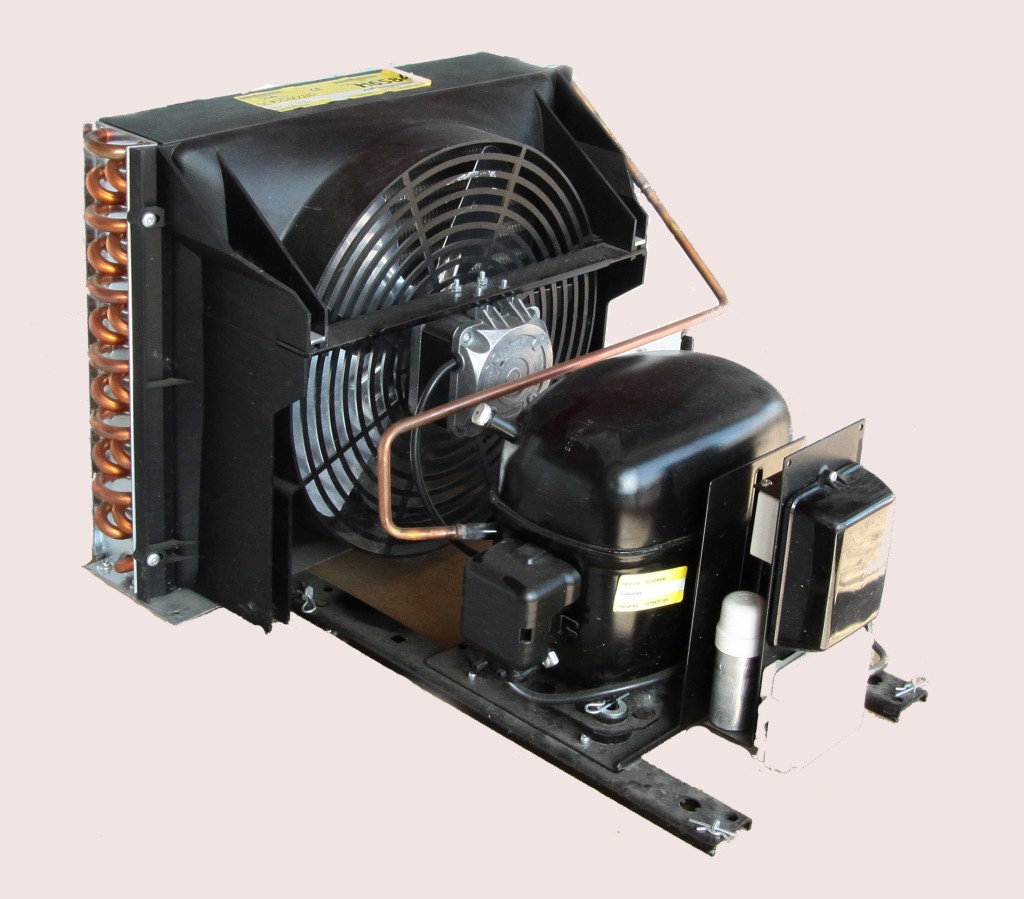
In the photo - the external unit of the refrigeration unit.
The thermal power of industrial installations can be tens of kilowatts.
crazy hands
Refrigeration equipment for the cellar can be not only industrial, but also handmade.
- The donor of the compressor and radiators was an old refrigerator. The case was carefully opened, the tubes for freon were bitten.
- The compressor and condenser were located above the level of the cellar, in a barn built above it. The evaporator is in the cooled room itself. Forced blowing of both heat exchangers was organized.

- New copper tubes connected the components of the system with the assistance of a refrigerator repair specialist. He filled the system with freon.
- Condensate was drained in the simplest way - with a hose into a 20-liter canister.
- To adjust the operating mode, a simple timer was used. The device was set to a mode in which an hour of continuous operation of the compressor was replaced by an hour of downtime.
What was the design capable of, the price of which, taking into account the payment for the services of a specialist, was no more than two thousand rubles?
The temperature in the cellar, according to the designer, did not rise above +9 degrees on the hottest days.
The cellar is completely dry due to water condensation on the evaporator. The condensate is forgotten like a bad dream. If at first the 20-liter canister was filled in a week, then at the time of publication of the report it had to be emptied only once per season.

Water cooling
The study of medieval construction in the Middle East brought a curious discovery: it turns out that air conditioning systems where more years than is commonly thought. The so-called "wind catchers", towers, outwardly very reminiscent of deflectors on chimneys, served to cool the air inside the building.
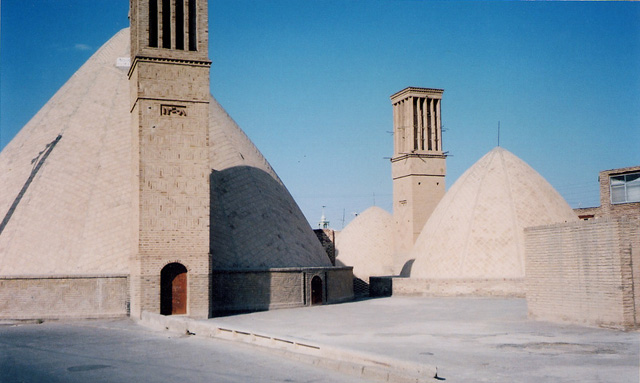
The wind catcher is a traditional part of Persian architecture.
How does such a scheme work?
- When the wind in the tower creates a vacuum. The mechanism, if the author's memory serves, is described by the Boyle-Mariotte law: in a moving gas or liquid flow, the pressure is lower than in a static medium.
- As a result, there is a thrust, and the air on the way to the tower passes sequentially through an underground channel with water and living quarters above it. Water due to contact with the ground at a noticeable depth has a fairly low temperature; evaporation further reduces it, moistening and cooling the air.
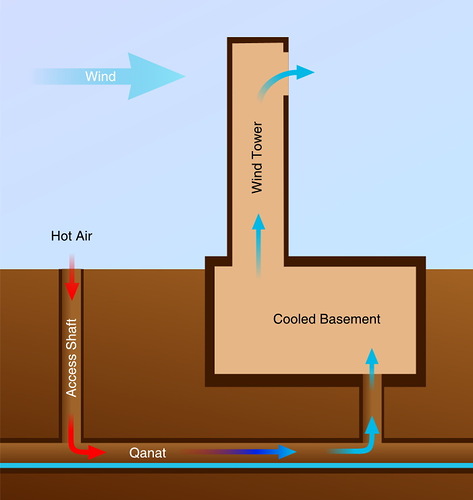
How can this mechanism be implemented in a cellar located near a well? Just put an exhaust hood with a deflector; air flow is organized through the second pipe, laid in the ground and opening in the well just above the upper level of the water table.
Nuance: the deflector is effective only with wind.
In calm weather, ventilation will be carried out due to the natural difference in density between warm and cold air; the air exchange rate will be noticeably lower.
Useful little things
What other tricks can help us organize a cold enough cellar?
- Thermal insulation of its upper part. The method is at your discretion: it can be pasting with foam from the inside or laying an insulated screed from the outside.
- Insulation of the door or hatch to the cellar.
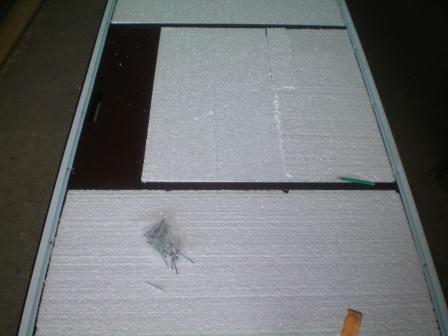
- At the construction stage - the maximum depth, and first of all, the deepening of the upper floor.
What is the instructions for? All with the same constant ground temperature below the freezing level. If the ceiling is deeper than this mark, and the entrance is well-insulated, the temperature in your vault will never exceed the cherished 12 degrees.
Conclusion
We hope that we have helped the reader to find a suitable solution for themselves. The video in this article, as always, will offer additional information on the topic under discussion. Good luck!
